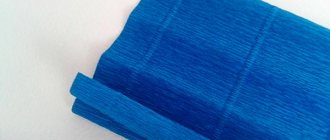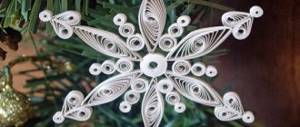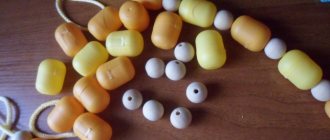And, unlike classic flower pots, stationary containers can be decorated as you please.
For example, in the form of a huge basket. It is beautiful, catchy, and at the same time harmonious - because aesthetically, the basket matches any plants and any style of garden design. Many gardeners plant flowers in old baskets, but they too often look very unsightly. Therefore, in order to create a truly stylish garden accessory, you should not use an ordinary old basket, even if it is very large - it will still be small for a real flowerbed, and it will not please the eye with its originality. It’s better to “weave” a stylized basket yourself, especially since it’s not at all difficult.
What about the costs?
EVERYTHING YOU NEED FOR THIS ARTICLE IS HERE >>>
Virtually none, since all the materials for making a flower bed-basket will probably be found at your dacha.
Paper basket
You can buy wrapping paper or use leftover wallpaper. Cut a large piece to a width of 76.2 cm, fold the edges inward and fold the paper into strips 10 times. Sew both sides of the resulting blank on a sewing machine, retreating 0.5 cm. Make 8 such blanks from the stitched strips.
Intertwine them and get a large mesh, gluing the strips at the points of contact. Bend the free ends inward and secure with hot glue. If desired, decorate the finished craft at your discretion to add beauty.
Making a laundry basket with your own hands
If you're having trouble finding a laundry basket that matches your bathroom's height and volume, try making one yourself. This basket can be used not only for laundry, but also for storing clothes, toys, textiles, and any large or small things. Make washing a little more enjoyable!
For a basket with a height of 55 cm and a diameter of 31 cm you will need:
- metal mesh - 110 cm;
- gray linen or burlap (length) - 102 cm + 34 cm for the lid;
- light linen (length) - 102 cm + 34 cm for the lid;
- cardboard 32 x 32 cm;
- sewing machine;
- thread and needle;
- wire cutters;
- wire;
- pliers;
- scissors;
- tailor's needles;
- a simple pencil;
- construction gloves to protect hands.
Time spent: 1 hour 20 minutes.
Step 1
Using wire cutters, prepare a piece of metal mesh of the required size. The mesh will be the base of our laundry basket. To protect your hands from sharp elements, it is better to wear thick construction gloves at this stage. The mesh is stored in a roll and will take on the correct round shape.
Step 2
We connect the edges of the mesh. To do this, you need to form an overlap of 2-3 cells and twist them with wire. At this stage, pliers may come in handy.
Step 3
Let's start sewing the cover for the outer part of the basket. I used a piece of coarse gray-brown linen measuring 62 x 102 cm. We fold it lengthwise with the right sides inward and machine stitch it. You can zigzag the edge of the seam and the top of the workpiece to prevent the fabric from fraying.
From fabric of the same color, cut out a circle with a diameter of 32 cm.
We fold the edge of the circle and the fabric blank with the right sides facing each other and grind it on a machine.
The result is a cover that can be easily placed on the mesh. The top edge needs to be folded inside the basket.
Step 4
We cut out a piece of 65 x 102 cm from light flax. We repeat all the same steps as with gray flax. Place the finished cover in the laundry basket, inside out. Since the light-colored cover is taller, there is enough fabric left to wrap it around the outside of the basket. You can use cotton lace, pompoms or braid as edge decoration.
Step 5
Now let's start making the lid. Its base can be made of cardboard, thin plastic or a dense laminate backing. Cut out a circle with a diameter of 32 cm. Prepare 2 circles of white fabric, the diameter of which is equal to the cardboard blank plus 2 cm for allowances.
Cut out a strip of light fabric 25 x 10 cm, from which we sew a handle for the lid. Fold it crosswise with the right side inward, machine stitch it, turn it inside out and iron it.
We bend the workpiece as shown in the photo and steam it with an iron.
We attach the handle to the circle of fabric exactly in the middle and sew it on the machine with a zigzag seam.
We fold the round blanks for the lid right sides together and grind them down exactly halfway. Turn it inside out and insert the cardboard circle.
We sew the remaining part by hand with a hidden seam.
The cart is ready! If desired, you can make an inscription or drawing on it using acrylic paints on fabric.
This basket will help you store your laundry beautifully. Happy crafting!
Creating a laundry basket
Having gained experience, you can work on a new material - fabric, making a laundry basket out of it with your own hands. Buy a piece of metal mesh and shape it into a basket by connecting the edges and screwing them with wire. For the cover, select a piece of plain fabric 62 by 102 cm. Turn it facing inward and sew it on a machine. Make a circle with a diameter of 32 cm from the same fabric.
Stitch it together with a fabric cover, put it on the mesh, and carefully fold the upper end inward. We are preparing the same cover from elegant fabric to match your bathroom. We put it on the lower cover and decorate it with elements - lace, braid, pom-poms.
DIY storage basket made of metal mesh
a storage basket
that’s perfect for you .
It happens that a workshop, office or home needs a storage basket, and the ones on sale are certainly beautiful and convenient, but do not fit in size. Therefore, one basket needs to be made...
It is quite easy to bend a basket from a mesh; this will require one sheet of metal mesh, and it will also make several small baskets.
In addition, you need: - wire cutters or metal scissors - long-nosed pliers - workbench, metal ruler or angle - hammer - thick gloves
1. First, mark and cut the mesh to size. To do this, decide what size basket you need in terms of height, width and length, and then, taking this into account, mark the base and sides of the future basket.
PLEASE NOTE that it is necessary to leave long protruding ends of the mesh on one side of the future walls. This is necessary for connections.
2. Use a ruler to bend each side in turn. The end result should be a storage basket that fits your size.
3. Next, use pliers to bend the long ends of the wire around opposite corners - this is how we connect and secure the sides. Don’t be shy and press with pliers to smooth out the wire and secure the walls. If necessary, use a hammer.
Of course, the first DIY storage basket you end up with will not be intended for exhibition, but beauty will come with experience. In addition, a homemade basket can be refined. Sew a fabric cover so that it extends over the top edge - this kind of basket can be placed anywhere in the house.
You can store things in it in the laundry room or bathroom.
Or you can assemble your own mini-warehouse for the workshop by making storage baskets with your own hands for existing factory shelves and racks.
Fruit basket
You can use veneer for a fruit basket; it is easy to weave. Pre-soak the veneer in water at room temperature for one hour and hang it to dry. We cut the dried material into equal strips. We lay one part on a flat surface and fix it so that it does not move. We begin the weaving process according to the usual pattern until we obtain a square.
Align the remaining ends by weaving strips along the entire length. Then there are two more of the same kind. Align the intersection lines. We finish each side of the square with three long strips until the desired length is obtained. We fix the ends inward. It makes an excellent basket made of dense material.
Toy basket
If you want to make a basket for toys yourself, you need to take into account the height of the baby. It should be convenient for him to put toys in and take them out. Be sure to choose natural materials. We create a mesh frame (as in the previous work), cut out rectangles from two pieces of fabric according to the size of the sides of the frame, and prepare a circle for the bottom.
We sew the rectangles into the pipes and attach the bottom. We insert a metal mesh inside the cover. We stitch or hand sew the edge. You can put toys together with your baby.
Waste basket
The basket is called so because it is made from unnecessary things. Old denim trousers, fabric with a beautiful pattern, the remaining piece of linoleum, a piece of padding polyester of the same size, or batting will do. We create a base from linoleum, fastening it along the edges with a stapler.
We sew two fabrics - the inner one from old trousers and the outer one from a nice fabric, sew on the round bottom. We prepare the same bases from thick materials, put them inside a double cover, and sew the edges tightly with strong thread.
Wicker
The oldest type of basket is made of twigs. They are selected by bending. If they don't break, the rod is ready. They are first soaked in cold water for at least 14 days, changing the water every day. You can soak it in boiling water: pour it over the rods and boil for two hours. The result will be beautiful material, bright and shiny vines. Weave a basket, starting from the base, according to the old grandfather’s method.
By starting to create baskets for your home, you can solve problems with laundry and toys, save money, get rid of old things, giving them a new life, and get positive emotions from the results of your work.
Question answer
Felt, non-woven fabric, newsprint, even plastic bottles will do. They are cut into squares, fastened with an awl, crocheted, secured with wire or thick threads, gradually collecting the elements into a basket.
First of all, such a basket must be left to dry completely. This will take several days. The dried product can be painted in any color of your choice and coated with transparent varnish. If you want to turn it into a gift, use decorative elements.
For younger children, there is a non-traumatic option - a frameless basket. It will be given shape by a sealant - padding polyester, non-woven fabric, an old blanket folded in several layers. Insert it between two covers, and the basket is ready for use. Kids can even use it as a playhouse.
How to make a decorative basket with your own hands
On Easter, every family, every home will have colorful Easter eggs, which are an integral part of this holiday. And in order to place Easter eggs in the center of the holiday table, you will need a beautiful dish.
For such a dish, we suggest using a decorative basket, which you can make with your own hands in a matter of minutes. The basket looks very unusual, in the form of a huge bird’s nest. In the future, such a basket can be used to store sweets, jewelry, etc.
To make a decorative basket you will need the following materials: thread, PVA glue, balloon.
You can use threads in a variety of colors to make a decorative basket. It can be pink, red, bright yellow or light green. And if you want to achieve the effect of a realistic bird's nest, then use gray, beige, brown or black threads.
Interesting garden decor: 20 photos and descriptions
Garden decor made with your own hands makes the area not just beautiful - it creates a warm, “homey” atmosphere.
Such jewelry can be very diverse - different sizes, different colors, created using different techniques. Sometimes it can be helpful to look for garden ideas in other areas or in photographs in magazines or websites. You don’t have to copy the decor exactly - if you bring something of your own, it will be much more interesting.
Mesh flowers
Let's look at the title photo of the article and see that you can make amazingly beautiful flowers . It’s quicker to make this type of garden painting from mesh, and you can use both metal mesh and plastic mesh. Here is a small material on the topic of such crafts. If you only have wire, the work will take longer, but the flowers can be made much more decorative using weaving. We attach large flowers made of wire and mesh to any surface.
Decorative tree
To create such a luxuriously flowering tree you will need a base. This could be the trunk of a dried tree (and you won’t have to uproot it). If such a tree is not in the right place, find it somewhere else and dig it in. Fix it securely in the soil. The lower part can be covered with crushed stone and even filled with cement mortar. We hang pots with wildly flowering plants (for example, petunia or sulfinia, etc.) on large tree branches.
Supports for climbing plants
An original support for climbing flowers in the shape of a butterfly is made of wire. The work is no different. The main thing is to monitor the growing shoots and direct them to the butterfly’s wings in time.
Decorative support for clematis or other climbing plants. To a vertical support (for example, a pipe), firmly fixed in the ground, slats are attached in a horizontal position. This decor will be good on the lawn (plants can be planted on both sides of the support), and in any other place on the plot.
Large bright flowers
Anyone who knows how to cut and weld metal can make such incredible flowers for the garden. For those who are not capable of this technique, create something similar using large plastic bottles as the material. For example, such as in the bottom photo. Cut off the neck of a large plastic bottle along the shoulders, cut the container into petals, and round them. Then we paint the flowers and attach them to the right place.
Options for cardboard and paper baskets
Paper and cardboard are the most accessible and inexpensive materials for crafts. It can be easily changed in shape, so even a child can handle it. From cardboard you can make baskets of various shapes, different colors, different sizes up to dolls, baskets for themed holidays, as well as functional items.
Corrugated cardboard basket
The top layer of corrugated cardboard needs to be removed, then it will become more flexible. You can pre-paint it with any paints in the desired color. Then cut into strips 3-4 cm wide. For a medium-sized basket, cut a strip 43 cm long. This will be the rim.
For the handle you need a strip 36 cm long. For the bottom, cut four strips 28 cm long and arrange them crosswise. Glue all the parts together or fasten them with a stapler. You can decorate the basket with ribbons, bows, and paper flowers.
Basket made of newspaper tubes
The newspaper needs to be cut into strips and formed into tubes by winding them on a knitting needle. Paint them in the desired colors and dry. For an average basket you need about 100 straws. They need to be folded in pairs and formed into a cross. Attach a long tube to the center and fold it in half, using it to weave. The vertical columns are first braided two together, and then each one. After a few rows, glue several additional vertical posts.
It is more convenient to put the product on the jar, then the weaving will be even.
When the height is sufficient, the stand can be cut. And the main weaving tubes are built up in a different color. Next, the weaving changes: the leftmost one needs to be wound not behind the adjacent one, but behind the fourth rack. Do the same with the next tube. Trim the ends and hide them. To prevent the basket from bending, you need to prime it with PVA glue and varnish it.
Paper basket
You will need wrapping paper. Even wallpaper will do. You need to cut ribbons out of paper, fold them several times in length and stitch them with thread. Threads need to be black or to match the color of the basket. From these blanks we begin to weave a basket by throwing strips one after another. The result is a lattice that holds its shape. To secure the manufactured product, we fasten it with silicone glue.
LiveInternetLiveInternet
Quote from Katra_I
Read in full In your quotation book or community!
Sweets for beloved men
Gift for February 23: a bouquet of sweets. Master Class
Source - https://www.supersadovnik.ru/masterclass.aspx?id=1065
Men love sweets no less than women (contrary to the existing stereotype). That's why we came up with a special men's bouquet of sweets. Both the boy and the husband will like this. These are sweet abacus, which by the way are a symbol of prosperity in the house.
Materials
- foam board 3 cm thick
- black corrugated paper 30 cm
- gold ribbon 3 cm wide 170 cm wide
- drying 60 pcs.
- chocolate 13 pcs. 7.5 x 3.5 (cm)
- gold cord 60 cm
- kebab skewers 6 pcs. 20 cm long
- toothpicks 8 pcs.
- banknotes printed on a printer
- chamomile 3 pcs.
- gold acrylic paint
- hot melt adhesive
Tools
- hot glue gun
- stationery knife
- scissors
- ruler
Cut out blocks of penoplex with a width of 3.5 cm and dimensions: 2 pcs. 22.5 cm each and 2 pcs. 39 cm each. Cut the end of each block at an angle of 45 degrees. The cuts should go in different directions. The result will be bars that resemble long trapezoids.
Wrap each block with corrugated paper. Glue the seams overlapping with a heat gun. Be careful that all seams on the bars should only be on one side of the frame, since in the future they will be decorated with candies and chocolate.
Trim the excess paper from the ends of each block. Butt the ends of the short and long bars end-to-end to form a 90-degree angle. Glue each corner with hot glue. For a more secure connection, use a toothpick as a wooden nail. Connect all sides of the frame one by one
Paint the skewers and 12 dryers with gold acrylic paint. When they are dry, attach the skewer to the frame. To do this, insert a skewer into the longer piece of the frame so that it goes right through. Place dryers on a skewer in the following sequence: 4 plain, 2 gold and again 4 plain. Then pull the skewer with the dryers to the opposite bar. By the way, before you start working with dryers, the inner walls of the frame can be marked. Then the crossbars will be located at the same distance from each other.
Glue the gold braid along the entire outer perimeter of the frame. The base for the bouquet is ready. Place it in front of you, seams up. Now choose the location of the chocolates and all other decorations on the frame. Only after this start gluing the candies onto the base. Complete the composition by decorating the bills with flowers, gold cord, banknotes printed on a printer (you can also use real ones). Gift bills are ready. Now your man can taste the sweet life
Fabric baskets
Fabric baskets can be used for useful purposes, for example:
- as a laundry basket;
- containers for storing children's toys;
- stands for newspapers and magazines;
- boxes for needlework;
- covers for flowerpots and much, much more.
To create a basket, both plain and colored fabric is suitable. From the prepared fabric you need to cut two circles and two rectangles, the length of the rectangle should be equal to the perimeter of the circle. Fold the blanks back to back and stitch the circle to the rectangle. The basket is ready.
Finishing is at the discretion of the master; beautiful bows, flowers, lace, etc. will do. Such baskets can be decorated in Easter style, put Easter and eggs in it and take it to the temple for consecration.
Wicker baskets
Willow twigs (vine) are suitable for weaving baskets. Willow is easy to find along the river bank, but it should only be cut in the fall and spring when the branches are flexible. The harvested branches must be soaked in water for two weeks, changing the water daily. Then remove the bark from them and dry them.
The bottom is woven from eight rods, with holes pierced in half of them with an awl to obtain a cross. Encircle four twigs with two branches. This is how two circles are woven. Next, all 16 rods are braided separately. At the very end, another rod is added. Then the racks are bent to form a right angle and continue to weave to the full height. The last row is braided. For the handle, take a thick branch and braid it in a spiral with thin ones. The basket should dry within 2-3 days.
With such crafts, you can go to the forest to pick mushrooms, berries and herbs, and put fruits and vegetables from the garden in them.
If the basket is made oval and larger, then you can even carry a newborn baby in it.
How to make an original flowerbed from construction mesh
If you have leftovers from the construction mesh, do not rush to throw them away. Using your imagination, you can make a huge number of interesting flower beds.
Single-level and multi-level flower beds
A single-level flower bed is a frame in which plants are located at the same level. But you can make planting much more interesting if you use multi-level flower beds.
They are a cascading variety of flower garden. It uses a mesh to create steps of different heights. Unlike the raised one, it is characterized by a clear separation of the landing zones and the space underground thanks to the steps. So in a flower garden you can plant completely different plants, which differ in their requirements for soil moisture and acidity.
Production technology
Making an original design from a mesh is quite simple.
- First, it is given the required shape. It could be a circle, star, square, triangle, etc.
- In this case, it is important to bend the mesh correctly so that two walls are formed - just bend the product in half width-wise.
- Gravel is poured into the resulting opening - of any color, shape and size. Then the upper part of the mesh is sewn together using wire.
- As a result, you will have a frame for the flowerbed of the shape you have chosen. There will be a void inside, which is filled with soil - this is where plants are planted.
- Since the mesh is a fairly flexible material, it will be easy to give any shape. Among other things, you can make both single-level and multi-level flower beds.
Vertical flower bed
To make the product you will need:
First, a cylinder-shaped frame is made from mesh. There will be fabric inside it. A pot that fits the shape is placed down. Then soil is added. The soil should be watered to settle. If necessary, add more soil to compact it. The fabric is then cut in several places for planting - at the top of the structure. That's all, the resulting tower will only need watering after maintenance.
Vertical stand
You will need a mesh and several sheets of polyethylene. First select a grid shape. Then install it. Next, the polyethylene sheets are mounted inside the mesh so that soil can be scattered between them. You can only grow flowers on such a stand.
Original ideas
- Welded mesh will help you create real works of art. This way you can create a flowerbed-picture. The living landscape on the grid is simply framed by a wooden frame.
- Various original frames can be made from the mesh. It is not necessary to carry out simple projects - a beautiful butterfly with outstretched wings may appear on your site.
- Using mesh you can make excellent topiaries. Creating shapes from vegetation will become much easier. All you need is a net, support, imagination and plants with flexible stems.
Particular attention to gabion
From French, “gabion” translates as “stones in nets.” Structures of this type have been used for a long time to strengthen slopes, roads and embankments. But recently they have been actively used in parks and gardens.
You can use this type of mesh to create flower bed borders, wall supports, fences, garden benches and tables. Gray pebbles, dark granite, light sandstone, and colored stones are used as fillers.
Important! The diameter of the filler must be larger than the diameter of the mesh. In this case, he will not get enough sleep. The design of flower beds can be absolutely anything - from simple to intricate in the form of spirals. The flowerbed furniture looks original. Of course, it is not suitable for home. But in the garden it looks impressive. In addition to the flowerbed, you can make a fence or place a castle made of gabion on the site.
There are 3 main geometric shapes of gabions: cylindrical, box-shaped, flat. Moreover, they can be mesh or welded.
Box containers can have the following dimensions - length from 2 to 6 meters. Width – 1-2 meters. The height should be 0.5-1 meter. If you decide to make a larger flower bed, you will have to install special partitions - diaphragms. The boxes are made using mesh or welded methods.
- The welding method involves welding rods that are located at the intersection points perpendicular to each other. In this case, the grid cells will be rectangular. The walls are connected using wire.
- The mesh method involves attaching a mesh to a frame. The cells will have a hexagonal shape.
Weaving a basket in 2 evenings from any paper - a master class for beginners
Baskets and baskets help keep the house tidy and decorate the interior, so you can never have too many of them. Beautiful braids can be bought in the store, but it is much more profitable to learn how to weave them yourself.
- If you have a couple of free evenings and a pile of any paper, then you can weave a basket not only without financial losses, but also in the size, color and shape you need. And weaving baskets with your own hands is a very pleasant and peaceful process that you can do, for example, while watching your favorite movie.
And don’t let it bother you that the baskets are not made of wicker or rattan, because if everything is done correctly, then in appearance homemade baskets made from old papers will not differ from real wickerwork. Of course, they will not be as durable and moisture-resistant, but, nevertheless, they are ideal for storing most things.
For beginner craftswomen, we have prepared a step-by-step master class on weaving such a rectangular basket from kraft paper with leather handles. And at the end of the article you can see several ideas for using baskets of different shapes and sizes.
How to weave baskets from wicker and make money from it
People began to weave from vines a very long time ago. Previously, this activity was not considered something outstanding, as, for example, pottery was. Almost any villager, if necessary, could weave a basket or other piece of utensils.
Nowadays, wicker weaving is more perceived as creativity. In the modern world, wickerwork is not very necessary in everyday life, but is valued as handmade. Anyone who has patience, perseverance and, naturally, desire can learn to weave from vines. For many who have at least once tried to take up this craft, it has turned into an exciting hobby. At the same time, this activity can not only bring pleasure, but also be a source of permanent income.
Basket weaving workshop for beginners
In this master class we will talk about how to learn how to weave a basket from rectangular, square or round paper.
For work we will need:
- Kraft paper - you can also take baking paper, several paper bags, packaging mailing paper, pages of newspapers, magazines, etc.;
- 2 identical bases made of thick cardboard or fiberboard, cut in a square or rectangular shape - you can choose cardboard if you want to weave just a basket just for storage, and if you like the idea of a basket-tray like in this master class, then use size 24 fiberboard ×38 cm, thickness 2.5 mm.
Important: if you want to weave a basket with higher walls than in our tutorial, then you will need some kind of auxiliary template, for example, a shoebox. The template will help you weave a basket of the correct rectangular shape. The cardboard base in this case should correspond to the size of the box.
- Wooden kebab skewer or thin knitting needle;
- Scissors;
- Any paper glue and stronger glue, for example, “Moment”, as well as double-sided tape;
- Transparent matte water-based acrylic varnish in a spray or can;
- Long narrow leather belt (preferably size XL);
- 8 brass cap nuts, 8 brass flat head Phillips screws, 8 brass washers (available at hardware stores, the entire set of fasteners will cost you about 70 rubles);
- An electric drill or awl to make holes in the leather belt;
- Marker.
Basket weaving: a step-by-step plan for starting a business
If you are just starting your own business, do not rush to register your business. First think through the questions:
Where to get raw materials for baskets.
It can be collected from places where willow grows, or you can grow it yourself.
- Where to store prepared material and finished products.
The basket weaving business is well suited to rural areas where storage space is usually not a problem. In urban environments, a garage is suitable for these purposes.
- Sales channels for ready-made baskets.
Once you have made several baskets, think about distribution channels for your products. You can sell your products through advertisements placed in newspapers or on the Internet. Create your website and take advantage of online advertising opportunities. The first works can be realized through friends and relatives - these can also be gifts. If the products are made with high quality, word of mouth will work. When there are a lot of baskets, try to negotiate with stores about selling products. You can sell baskets at exhibitions and/or fairs. Read how to learn how to sell.
When the main organizational problems have been resolved, and you feel that things have moved forward and it suits you, register a form of doing business. For the initial stage, IP is sufficient.
Basket weaving is a suitable direction for developing a family business. All family members, including children, can be involved in the matter. Children will be happy to help collect willow twigs and prepare them for further work. All income goes to the family budget.
Instructions
Step 1. Making tubes
To do this, you first need to cut the paper into equal sizes, for example, A4 or A5. Suppose you chose old newspapers to make a basket, which already have the size we need. Next we need to cut the newspaper pages into strips - future tubes. Here's how to do it quickly:
- Open the newspaper completely, then fold it in half lengthwise and press the fold.
- Now take a kitchen or utility knife and cut the newspaper at the fold. It is advisable that the cut areas be smooth and not frayed.
- Separate half of the resulting stack of paper, bend it lengthwise and cut it again. You will get strips about 10 cm wide. Now carry out the same procedure with the remaining stack of paper.
- Next, sort out those strips that have light edges without text or pictures - it is from these strips that you will get white tubes. They are more convenient for work, because they are easier to paint to resemble rattan or wicker. But this does not mean that you cannot use colored strips; it is simply advisable to first coat the tubes twisted from them with light paint, or paint them more densely (we’ll talk about the nuances of painting below).
- So, let's start twisting the tubes. Place a wooden skewer on the very edge of the strip (but not on the white one!) at a minimal (!) angle and try to tightly screw the paper onto it (photos 1 and 2). At first, this can be done on the table, twisting the skewer and holding the paper, and when you reach the middle of the tube, you can lift it up and continue twisting.
When you only have the tip left, you need to lightly grease it with glue and only then screw it to the end (photo 3). Woo-ala, the first tube is ready! All that remains is... to wind another 100-500 of these tubes (the exact number depends on the size of the basket). Don't be afraid, it's not that difficult or time-consuming, but patience will help here.
Weaving willow baskets for beginners step by step
Let's consider one of the methods of weaving a basket with a diameter of approximately 28 cm and a height of about 12 cm.
Read on the topic: MDF kitchen facades: do-it-yourself repair, painting and restoration
We will need the following materials:
- 6 thick willow branches (future knitting needles);
- 24 rods of medium thickness (for the side parts of the bottom);
- 50 thin branches (25 for racks and 25 for walls);
- 12 rods of medium thickness (for special weaving designed to connect the base and walls).
There are five stages of basket weaving in total.
Stage 1: basic
Using pruning shears, cut 6 rods 35-40 cm long from a thick shoot. They will serve as basic knitting needles.
In the center of each of these three rods, use a knife to make a split 4-5 centimeters long. This split is called a "slit".
Place three split rods together and insert the remaining whole rods into the slots to form a cross.
Now we begin to weave the base itself (bottom).
Select the longest and thinnest rods. Take two rods and insert their thin ends into the slot, as shown in the photo.
Separate the twigs, pass thick knitting needles between them and braid them like this, passing from above and below alternately. In this way, you need to make two circles to make a weave of two thin willow twigs.
Then continue to make the same weaves, only single ones, tightening the rods tightly and bending each of the knitting needles outward in turn. It is necessary to try to ensure that the distance between large branches is uniform, as the result should be a structure reminiscent of the spokes of a bicycle wheel.
The following picture clearly shows what exactly the pattern should be, obtained in the process of weaving around the knitting needles.
In the description of the method of weaving baskets from willow and wicker for beginners, one important detail is often missed, on which the quality of one of the most important elements - the bottom - directly depends. This is the need to tighten the rods as tightly as possible after each weave of the knitting needle, without moving them up or down!
Using the method described, continue working, moving in a circle, until the twig runs out.
To increase the length, you should not use two new branches at once. Simply insert the twig with the pre-pointed end between the old twigs from the last rows, bend it in the desired direction and continue weaving at least a few more moves forward before changing the second twig. Carefully trim the remaining ends. As a rule, replacement should be made when there is still about 10 cm left to the end of the branch.
The base of the finished product should be slightly concave so that the basket can stand firmly on the veranda or flowerbed in the courtyard of a private house photo. The technique for making the bottom clearly demonstrates that when the diameter reaches 7-8 cm, you need to tightly clasp it with your hands and slightly “push” the very center outward with your thumbs. However, it is important here not to overdo it and not to bend the base too much.
Continue weaving until the bottom reaches a diameter of approximately 22 cm. It is advisable to time it so that this moment coincides with the end of the next twigs, the ends of which should be fixed by tucking them between the branches of the previous row.
Cut the ends of the twigs with pruning shears as close as possible to the wicker base itself, but so that they still rest against the knitting needles.
Here the bottom is ready. For beginners, the result may turn out a little different from the photo, but this is completely normal.
Stage 2: breakdown of the base
At this stage, new branches are added to the weave of the base to each spoke, which will then play the role of racks for the further creation of the basket.
It is important to consider that each wicker rod has a natural curve with an inner and outer part.
For high-quality weaving of our basket you will need 24 such branches. Cut each of them with scissors or pruning shears to create a pointed and long oblique cut, located strictly on the inside or outside of the rod, but not on the side.
Holding the base with the concave side down, press an awl or screwdriver into the weave next to the knitting needle as shown in the photo.
Remove the awl and immediately insert the prepared rod with its inside down and another rod on the other side of the knitting needle. Using the same method, insert two branches into each spoke.
In various descriptions of weaving durable willow baskets for beginners, it is always indicated that the rods must be inserted with the inside down so that the product itself bends beautifully. If you insert them with the outside facing down instead, the basket will move apart.
On each stand, make a kink at a short distance from the beginning of the base weave (about 5 mm), simply pressing on them with your thumbnail.
Lift all the posts up, secure them with a hoop or tie them, making sure that there is no bending inward or skewing in any one direction.
Trim the bottom of the basic knitting needles at the same level as the edge of the weave, slightly below the bend of the posts.
Stage 3: connecting the bottom to the walls
One of the most important steps in weaving baskets is connecting the finished bottom with uprights to the side. In order for this transition to be uniform and look neat, use the softest light twigs of medium thickness in the amount of three pieces.
Place the basket on your lap with the base facing you - this will make it easiest to work with.
Take three twigs of uniform average thickness and trim their length so that it is the same. Insert their tips into those weaves on the bottom that are adjacent to the vertical posts. In order for the rods to hold tightly, their tips should go deeper into the base by about 5 cm.
Start creating the braided pattern with the leftmost twig. Hook it and throw it over the first and then through the second rack of the second row. Keep in mind that the weaving should not be on the side, but on the edge. This will allow you to obtain the most aesthetically pleasing connection.
Take the next twig, moving from left to right, and braid it around the posts in the same way.
Continue weaving around the entire base, always choosing the twigs one at a time and making sure that the branch you are working on is on top of the other twigs.
Read on the topic: How to grow basil on a windowsill and care for it
It is important to always tighten the rods tightly during the process, which will allow the product to obtain a beautiful shape due to good fixation of the racks at the very bottom. After the first round of weaving, place the basket vertically on a table or any other convenient surface. This will make the further work process easier.
Leave the small end of the twig sticking out, as shown in the photo. Start adding new branches from left to right, simply moving the old twig a little and inserting a new one into the resulting weaving gap. Make several weaves before adding the next twig.
As a rule, several circular weaves are enough to create a beautiful transition from the base to the walls. Pull the remaining loose ends down through the entire resulting weave, and then cut off with sharp scissors.
Stage 4: weaving walls
There are many patterns made from twigs of varying degrees of complexity, but when weaving a willow basket for beginners, it is better to use the simplest option, the diagram of which is presented below.
With an odd number of racks, it is permissible to use one rod as the basis of the weaving, but we ended up with 24 racks, so the best option is to weave from two branches.
Place the basket blank on a vertical surface, place some weight in it that will prevent the product from falling, and begin weaving. First add one twig, and only after throwing it several times over the posts in front and behind (approximately to the middle of the basket’s diameter) add the second one. Next, the branches need to be alternated, using one or the other in turn.
When the twig runs out, add a new one as shown in the figure. Always prune a branch before it begins to narrow too much, so that the weave does not have too thin parts.
After making a few circles, remove the hoop supporting the posts. If they begin to move too far apart, return the mount to its place. In total you need to move up about 9 cm.
After completing the main weaving, take three of the same twigs that were used to create the connection between the bottom and the walls. Secure them by simply sliding the ends under the posts.
Make several circles of weaving light-colored rods of medium thickness and secure the ends tightly using the same method as described above at the stage of connecting the base and walls.
Stage 5: weaving the bend
The final stage of making a basket is weaving a fold, to create which you need to bend the vertical posts and continue the pattern with their help.
Take the three light twigs used in the previous weaving, attach them to one post and bend it to the right. Do this for all vertical branches.
Then take one bent post and pass it under the third post, passing through the previous two.
Do the same with all the racks one by one, moving to the right. Make sure each branch is bent down tightly before using the next one.
When only three posts remain in a vertical position, stretch them according to the same pattern, only wrap the ends behind the existing weaves, tightening them tighter.
As a result, there should be long ends sticking out. Cut them off with an oblique cut.
As a finishing touch, carefully examine the product and remove all small ends using sharp scissors or pruners, being careful to make an oblique cut flush with the rest of the walls or bottom.
That's all the technology for weaving different willow baskets for beginners. With its help, both ordinary things and real masterpieces are created.
The original appearance of the products is obtained by using willow twigs of various shades in certain combinations.









